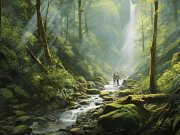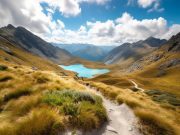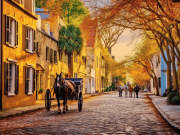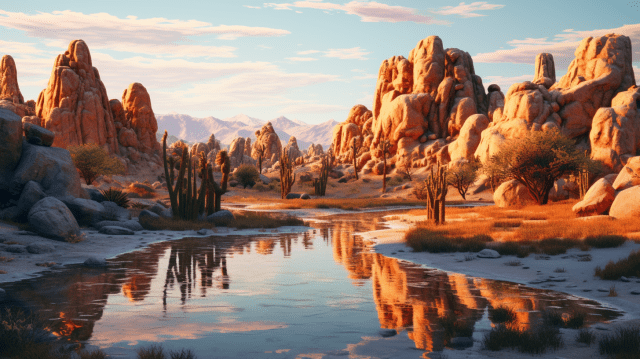Imagine driving through the arid landscape of Southern California, with nothing but sand and cacti for miles. Just as you begin to wonder if there’s anything worth seeing in this wilderness, you come across Joshua Tree National Park.
This desert oasis is a haven for nature enthusiasts, rock climbers, and anyone seeking adventure in the rugged outdoors. As you enter the park, you’ll be greeted by a stunning landscape of rocky mountains and twisted Joshua trees that seem to defy gravity.
Whether you’re looking for a challenging hike or a leisurely stroll through the desert gardens, Joshua Tree has something for everyone. With its unique blend of natural beauty and cultural history, this national park is an experience that will stay with you long after your visit is over.
So pack your bags, grab your camera, and get ready to explore one of California’s most iconic destinations.
Key Takeaways
- Joshua Tree National Park is a desert oasis in Southern California known for its unique landscape of rocky mountains and twisted Joshua trees.
- The park offers a range of activities, including hiking, rock climbing, scenic drives, and ranger programs.
- Visitors should be prepared for varying weather conditions and bring plenty of water and sunscreen.
- There are volunteer opportunities available for those who want to make a positive impact on the environment in Joshua Tree National Park.
Overview of Joshua Tree National Park
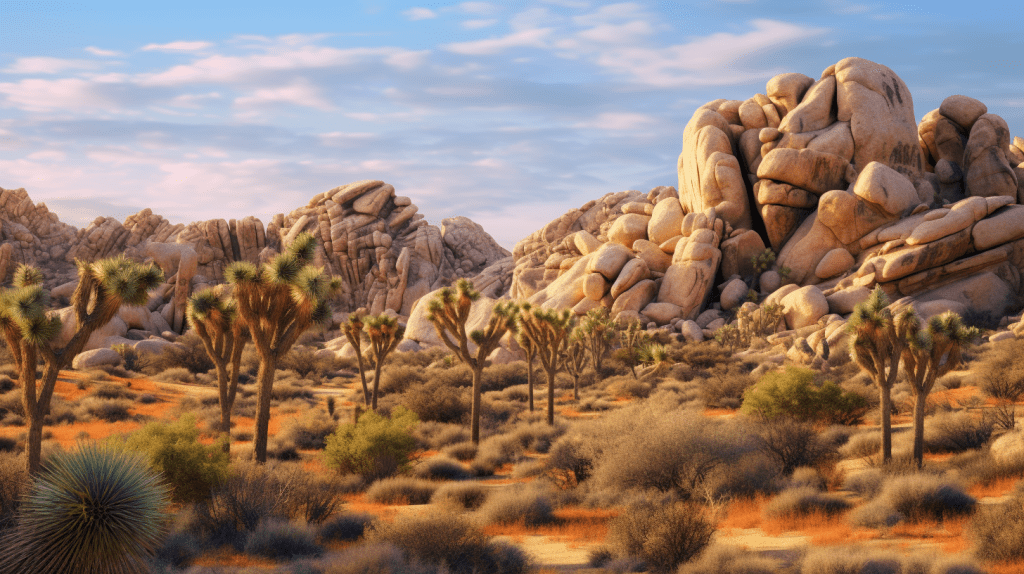
Now, let’s dive into the nitty-gritty of Joshua Tree National Park and why it’s a must-see destination for any nature lover.
With over 2.4 million visitors annually, this park is a testament to its natural beauty and appeal.
The climate conditions in the park vary greatly depending on the time of year, with hot summers and chilly winters being common.
But no matter what time of year you visit, you can expect stunning views of unique rock formations and an abundance of wildlife that call the park home.
As you plan your visit, there are many opportunities for hiking and rock climbing that will leave you feeling invigorated and exhilarated.
But don’t worry if outdoor activities aren’t your thing – there are plenty of scenic drives and picnic areas where you can relax and take in the stunning desert landscape.
So pack your bags, grab some water, and get ready to explore all that Joshua Tree National Park has to offer!
Planning Your Visit
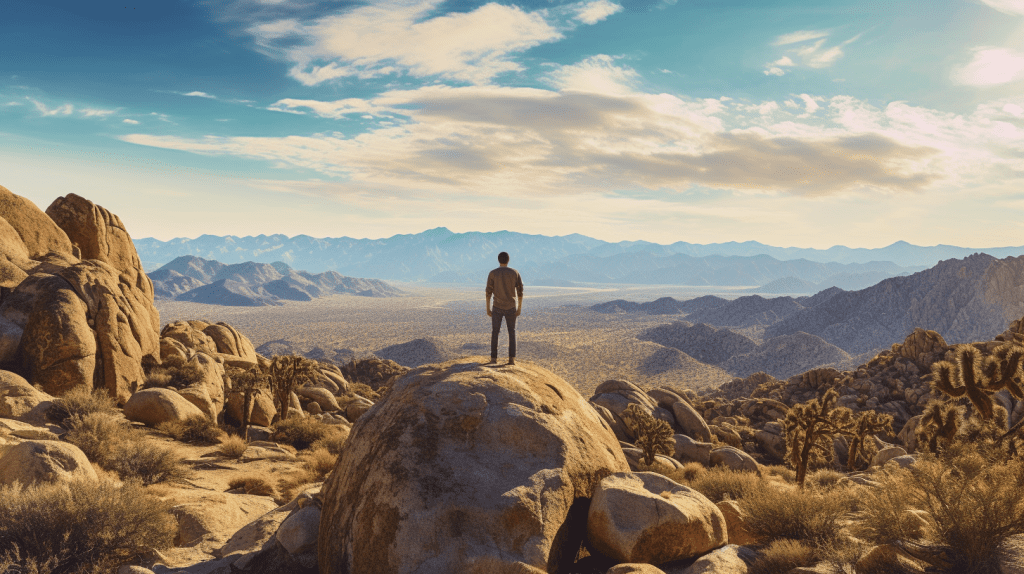
To make the most out of your trip to Joshua Tree National Park, you should take some time to plan ahead and consider all the different activities and trails available in the area.
The best time to visit is during the fall or spring when temperatures are mild and crowds are smaller.
If you’re on a budget, there are plenty of free activities such as hiking, stargazing, and rock climbing. However, if you want to splurge a little, guided tours and ranger programs provide an in-depth look at the park’s history and geology.
Make sure to bring plenty of water and sunscreen, as well as appropriate clothing for varying weather conditions.
With a little planning beforehand, you can experience all that this desert oasis has to offer.
Now let’s dive into exploring the park itself!
Exploring the Park
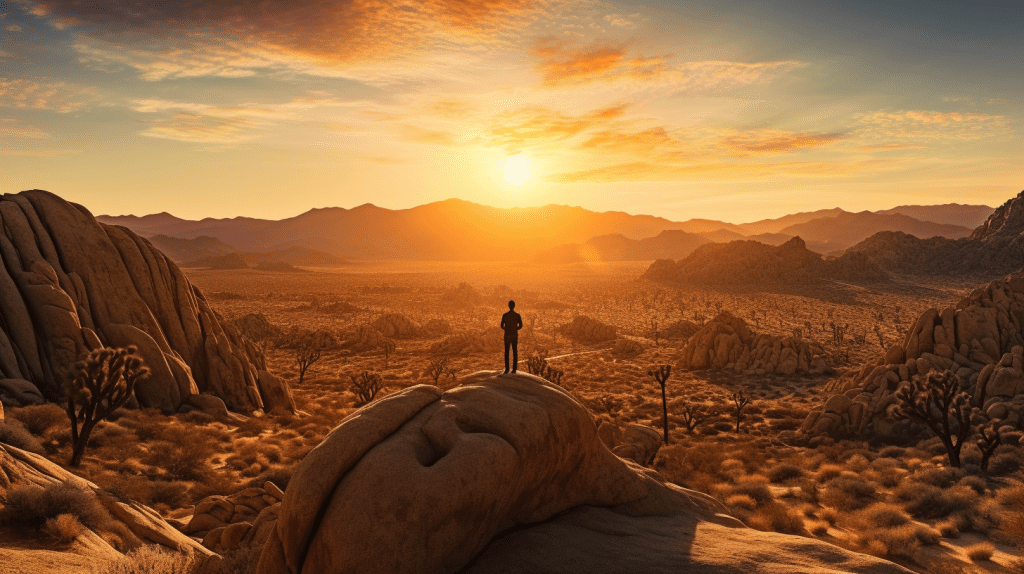
Now that you’ve planned your visit, it’s time to explore Joshua Tree National Park!
Lace up your hiking boots and hit one of the park’s many trails, each offering unique scenery and challenges.
For a more adrenaline-pumping adventure, take advantage of the park’s world-renowned rock climbing opportunities.
And if you’re looking for a more leisurely way to take in the park’s stunning landscapes, hop in the car and cruise along one of its scenic drives.
Get ready for an unforgettable experience!
Hiking Trails
Exploring the hiking trails within Joshua Tree National Park offers a unique opportunity to experience the natural beauty of the desert oasis. Before embarking on your journey, it’s important to choose the best footwear for your adventure and consider the trail difficulty.
Some of the most popular trails include Ryan Mountain, Lost Palms Oasis, and Hidden Valley. Each trail offers its own set of challenges and rewards, from panoramic views at the summit of Ryan Mountain to discovering a secluded palm grove at Lost Palms Oasis.
As you traverse through the park’s diverse terrain, be sure to keep an eye out for wildlife such as bighorn sheep and jackrabbits.
After completing your hike, transition seamlessly into exploring Joshua Tree’s rock climbing opportunities which offer an entirely new perspective on this breathtaking landscape.
Rock Climbing Opportunities
Rock climbing in Joshua Tree offers a thrilling challenge for experienced climbers seeking to conquer the unique formations and rugged terrain. The park is renowned for its bouldering opportunities, with over 8,000 routes available for climbers of all levels.
To fully experience this adventure, make sure to gear up with the appropriate safety equipment including helmets and harnesses. As you climb through the granite monoliths and twisted rock formations, feel the adrenaline rush as you push yourself further than ever before. Take in the stunning views of the desert landscape from above and revel in the sense of accomplishment that comes with conquering these natural wonders.
Whether you’re a seasoned climber or new to bouldering techniques, there’s no better place to test your skills than in Joshua Tree National Park.
Now that you’ve conquered the heights, let’s explore some of the scenic drives throughout this breathtaking oasis.
Scenic Drives
As you wind your way through the rugged terrain, you’ll discover hidden gems along Southern California’s scenic drives. Joshua Tree National Park is home to some of the most stunning overlooks and photo spots in the world.
Take a drive down Park Boulevard and marvel at the breathtaking rock formations that surround you. Stop by Keys View for panoramic views of Coachella Valley or head over to Barker Dam for a peaceful view of a desert oasis.
No matter where you go, there’s always something new to see and experience. And as you continue on your journey, keep an eye out for the diverse wildlife and plant life that call this park their home – from coyotes to bighorn sheep, and from cacti to yucca plants – there’s never a dull moment in Joshua Tree National Park.
Wildlife and Plant Life
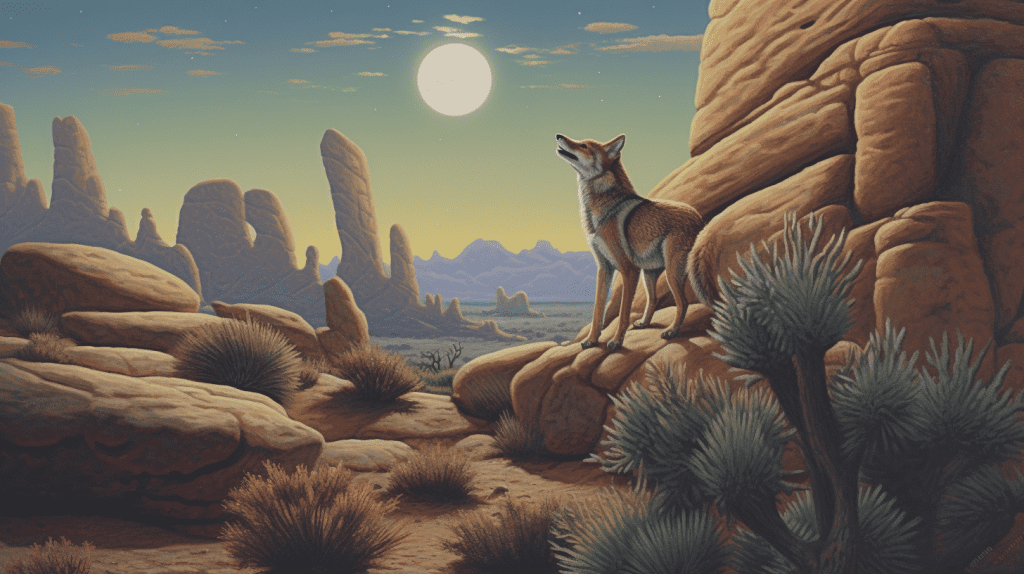
You’ll be amazed by the variety of wildlife and plant life in Joshua Tree National Park! The park is home to a diverse range of species, including some that are endangered.
From bighorn sheep and coyotes to jackrabbits and desert tortoises, the wildlife here is truly remarkable. And the plant life is just as impressive, with unique species like the Joshua tree itself, along with cacti, yucca plants, and more.
It’s clear that ecosystem preservation is a priority at Joshua Tree, making it an ideal spot for nature lovers and conservationists alike. As you explore this incredible landscape, keep your eyes peeled for these fascinating creatures and take in all the beauty around you.
And speaking of beauty…next up we’ll dive into the unique rock formations that make this park so special!
Unique Rock Formations
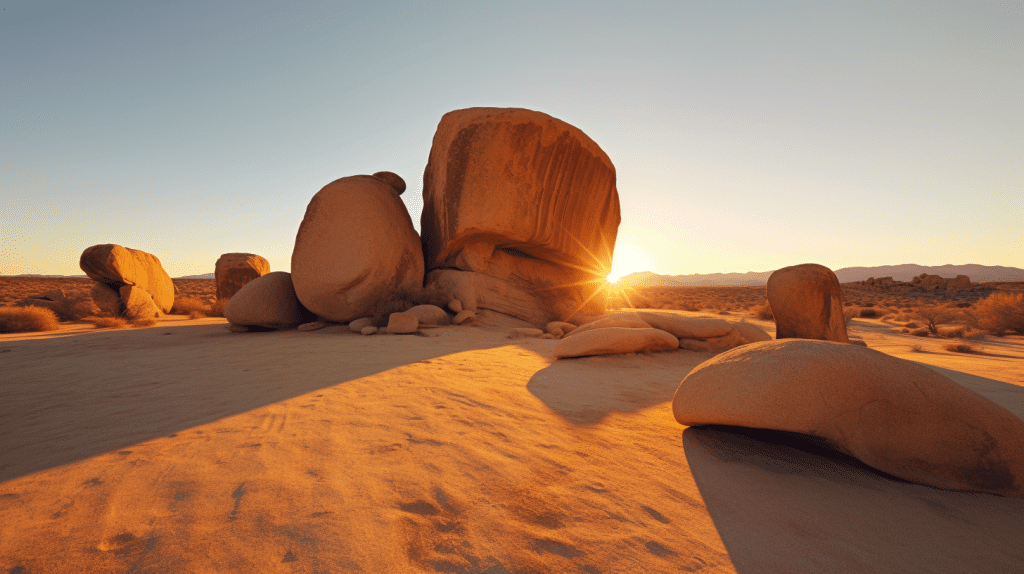
When wandering through Joshua Tree, don’t miss the chance to witness the incredible geological wonders and natural sculptures that make this place so unique. The rock formations here are truly otherworldly, with a variety of shapes and sizes that will leave you in awe.
As you explore, you’ll come across massive boulder piles, towering monoliths, and twisted spires that seem to defy gravity. Each formation has its own story to tell, shaped over millions of years by wind and water erosion.
Take your time to appreciate the intricate details on each one – from the jagged edges to the smooth curves – and let your imagination run wild as you try to decipher what they resemble. A few must-see formations include Skull Rock (which looks like a giant skull), Arch Rock (a natural archway), Split Rock (two boulders seemingly cleaved in half), Hall of Horrors (a maze-like area filled with tall pillars), and Jumbo Rocks (massive rocks piled high).
Witnessing these natural sculptures up close is an experience unlike any other – it’s as if you’re walking through a surreal art gallery created by Mother Nature herself. And speaking of nature’s artwork, be sure not to miss out on the stunning sunrise and sunset views that await in Joshua Tree National Park…
Sunrise and Sunset Views
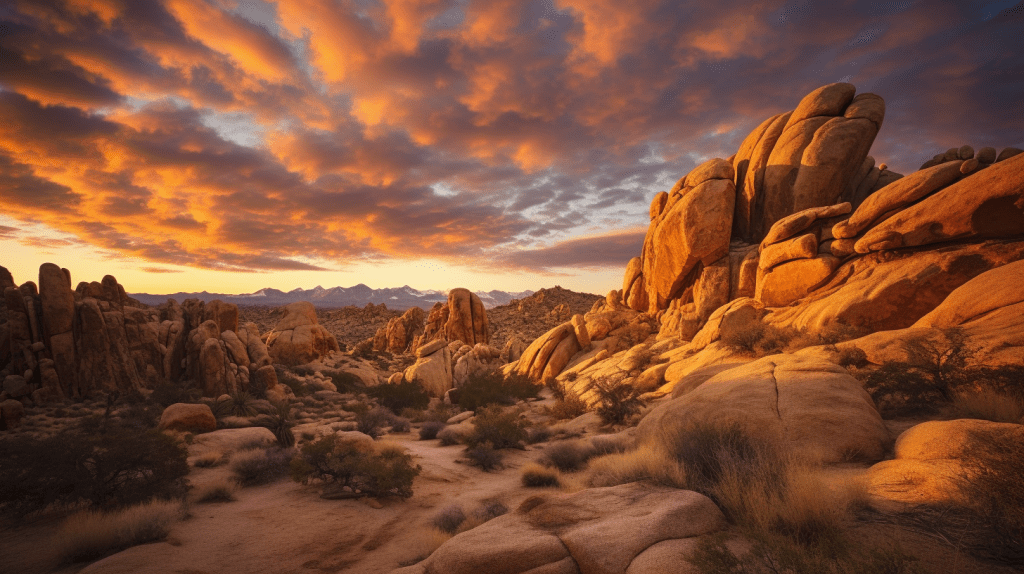
As you admire the unique rock formations in Joshua Tree National Park, make sure to set your alarm early and witness the breathtaking sunrise views. The best locations for capturing this moment are Keys View and Barker Dam, where you can see the sun rising over the vast desert landscape.
For optimal camera settings, try using a low ISO and aperture of f/8 or higher to capture the vibrant colors of the sunrise.
As evening approaches, head to Hidden Valley or Jumbo Rocks for stunning sunset views and don’t forget to adjust your camera settings accordingly.
As day turns into night, prepare yourself for some incredible stargazing opportunities in Joshua Tree National Park.
Stargazing Opportunities
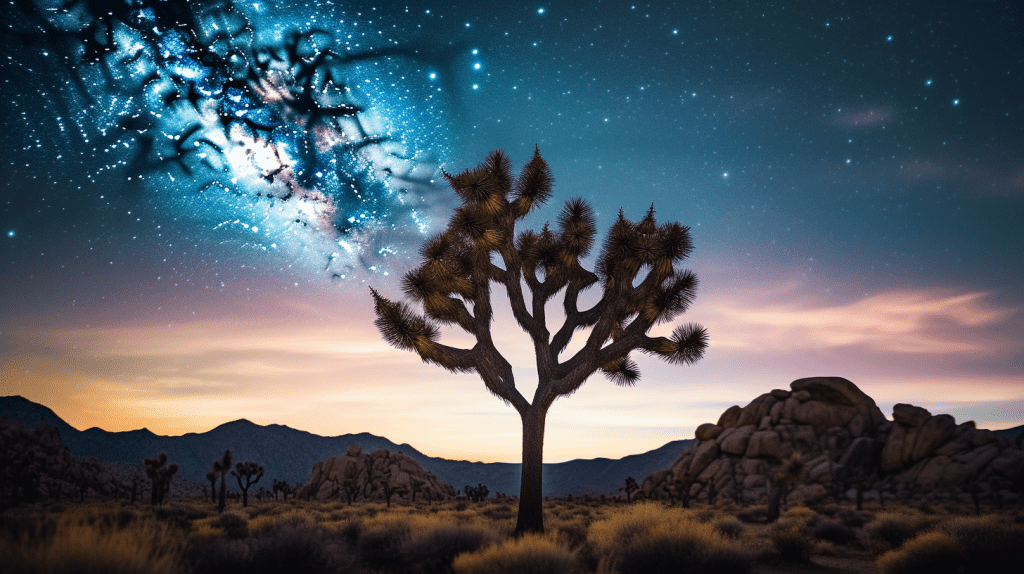
Take a moment to gaze up at the twinkling stars in the vast sky above, and let yourself be transported to another world. Joshua Tree National Park is known for its incredible stargazing opportunities, thanks to its location away from city lights.
Here are some things you might experience while stargazing in the park:
- A canopy of stars stretching as far as the eye can see
- Shooting stars streaking across the sky
- Constellations like Orion’s Belt and Ursa Major standing out against the darkness
If you’re interested in learning more about astronomy or night photography, Joshua Tree also offers astronomy programs and workshops on how to capture those stunning night shots. With camera in hand, you’ll be able to capture your own version of this beautiful nighttime landscape.
Now that we’ve talked about stargazing, let’s move onto some tips for capturing these scenes through photography.
Photography Tips
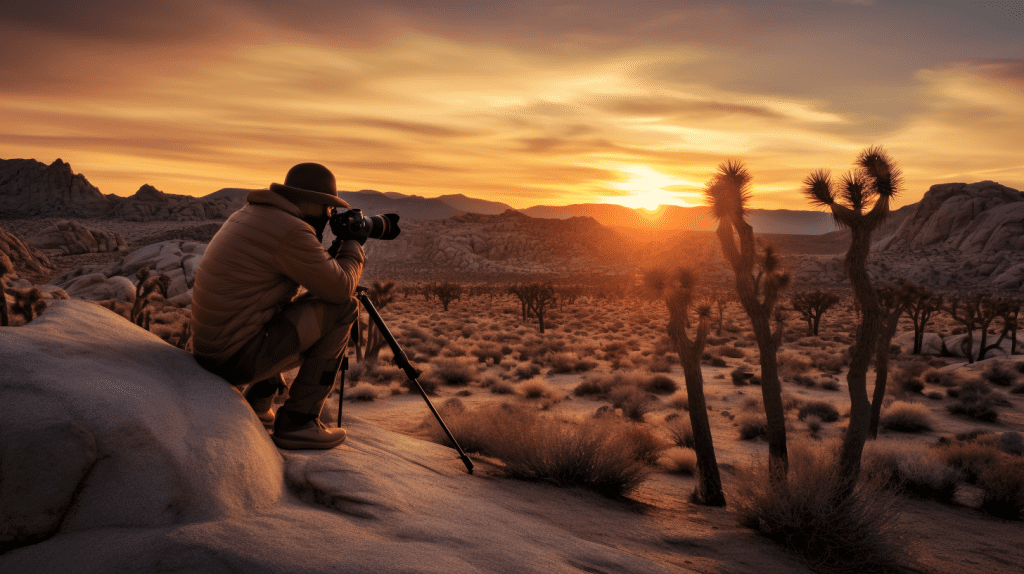
To capture the beauty of the starry sky above, all you need is a camera and these photography tips.
When it comes to camera equipment, make sure you have a tripod to keep your camera steady during long exposures. Additionally, consider using a wide-angle lens to capture more of the night sky.
As for composition techniques, try experimenting with different foreground elements such as rock formations or Joshua trees to add depth and interest to your photos. Don’t be afraid to play around with different settings such as ISO and shutter speed until you find the perfect balance for your desired effect.
Remember that patience is key when it comes to astrophotography – take multiple shots and don’t be discouraged if they don’t turn out exactly as planned.
Now that you’re armed with these photography tips, let’s move on to some safety tips for exploring Joshua Tree National Park at night.
Safety Tips
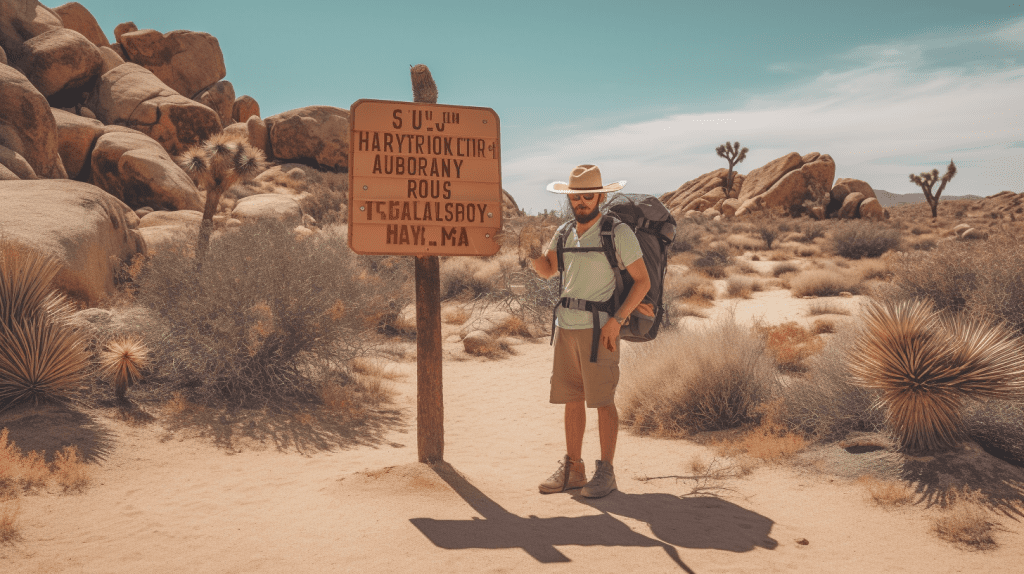
It’s important for you to prioritize safety when venturing out into the nighttime wilderness of Joshua Tree. This popular national park has a lot to offer, but it can also be dangerous if you’re not careful.
Here are four tips to help keep you safe:
1) Always bring plenty of water and stay hydrated, especially during hot weather or strenuous activity.
2) Wear appropriate clothing and footwear that will protect you from sunburn, scrapes, and other injuries that may occur on rough terrain.
3) Make sure you have emergency preparedness supplies with you at all times, including a first-aid kit, flashlight, map and compass.
4) Be aware of your surroundings at all times, watch out for dangerous wildlife like rattlesnakes or coyotes.
By following these guidelines, you can enjoy the beauty of Joshua Tree while staying safe along the way.
As for nearby attractions…
Nearby Attractions
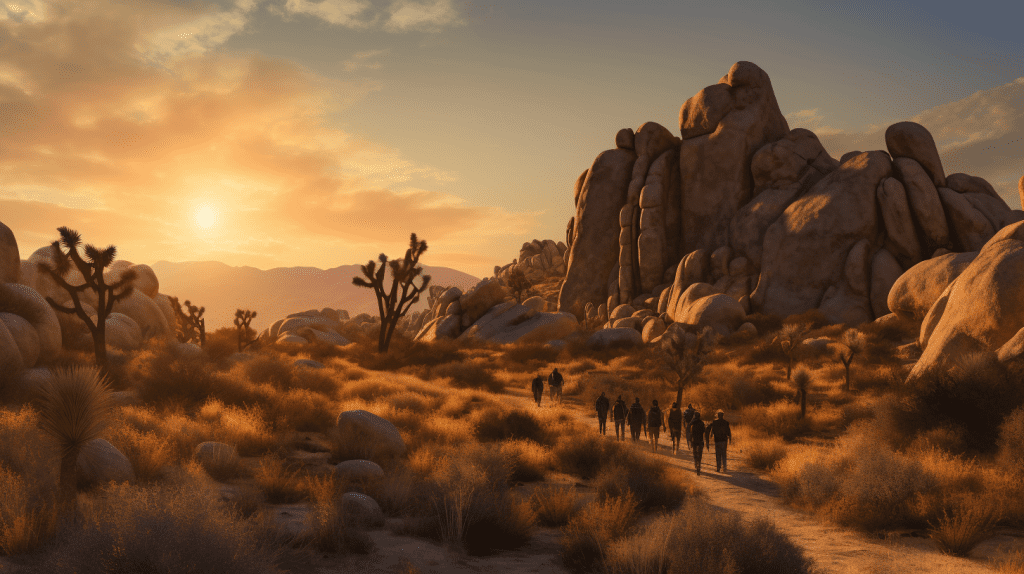
You’re in luck because there are plenty of awesome places nearby to check out after a day of hiking and adventuring in Joshua Tree.
When it comes to local dining options, you can head over to the nearby town of Yucca Valley for some delicious Mexican food at Los Palmas or try out The Frontier Café for some hearty American fare.
If you’re looking for more outdoor recreation, make sure to stop by Big Morongo Canyon Preserve where you can hike through beautiful trails and spot some unique wildlife. And if you’re up for a bit of a drive, don’t miss out on the stunning Salton Sea which is known for its eerie beauty and abundant bird watching opportunities.
With so much to do in the area, your adventure doesn’t have to end when you leave Joshua Tree National Park. Speaking of adventure, let’s dive into the history and culture of this fascinating region next!
History and Culture
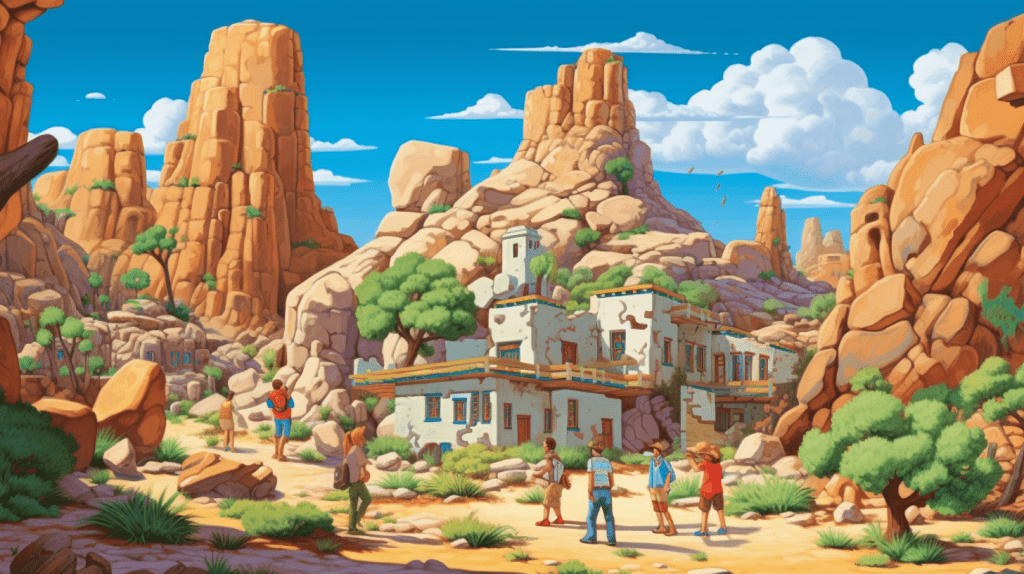
If you’re interested in delving deeper into the history and culture of this region, take some time to learn about the cultural significance and Indigenous presence that have shaped Joshua Tree National Park.
For centuries, various Native American tribes such as the Cahuilla, Chemehuevi, Mojave, and Serrano have called this area home. They relied on the desert’s natural resources for survival and developed a deep connection with their surroundings.
Today, visitors can explore ancient petroglyphs, pictographs, and other artifacts left by these tribes throughout the park. By learning about their traditions and way of life, you’ll gain a greater appreciation for the land you’re exploring.
As conservation efforts continue to protect this unique landscape for future generations to enjoy, it’s important to recognize the cultural significance of those who came before us.
Conservation Efforts
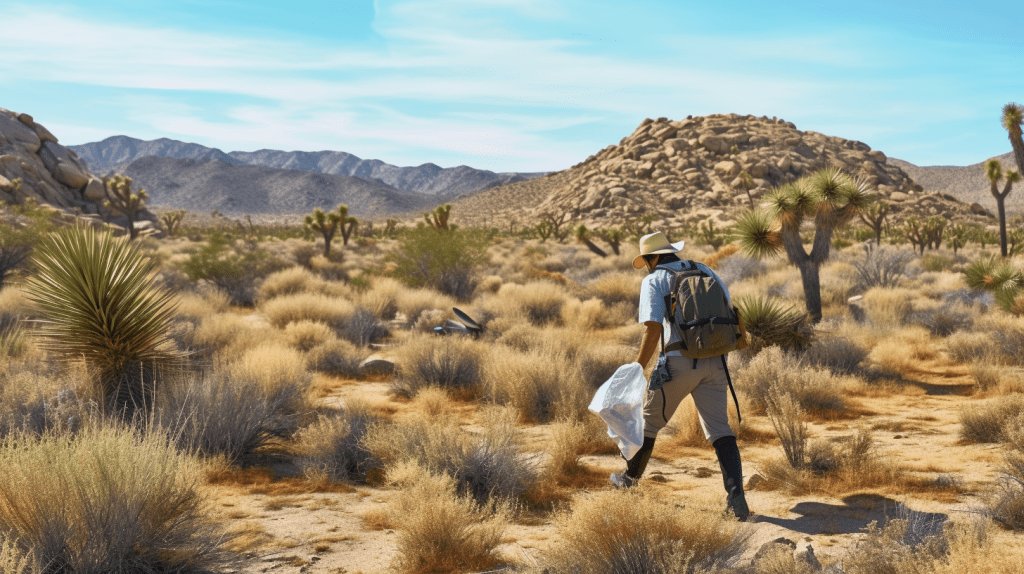
Preserving the delicate ecosystem and diverse flora and fauna of Joshua Tree National Park is a continuous effort that requires the support of visitors and local communities alike.
Wildlife preservation efforts include monitoring populations, controlling invasive species, and protecting habitats.
Community involvement is crucial in maintaining these efforts, as locals can assist with reporting any issues or concerns they may come across while exploring the park.
By understanding how our actions impact this fragile environment, we can all work together to ensure its longevity for generations to come.
Speaking of community involvement, have you ever considered volunteering your time to help protect this special place?
There are many opportunities available for those who want to make a difference in preserving this desert oasis.
Volunteer Opportunities
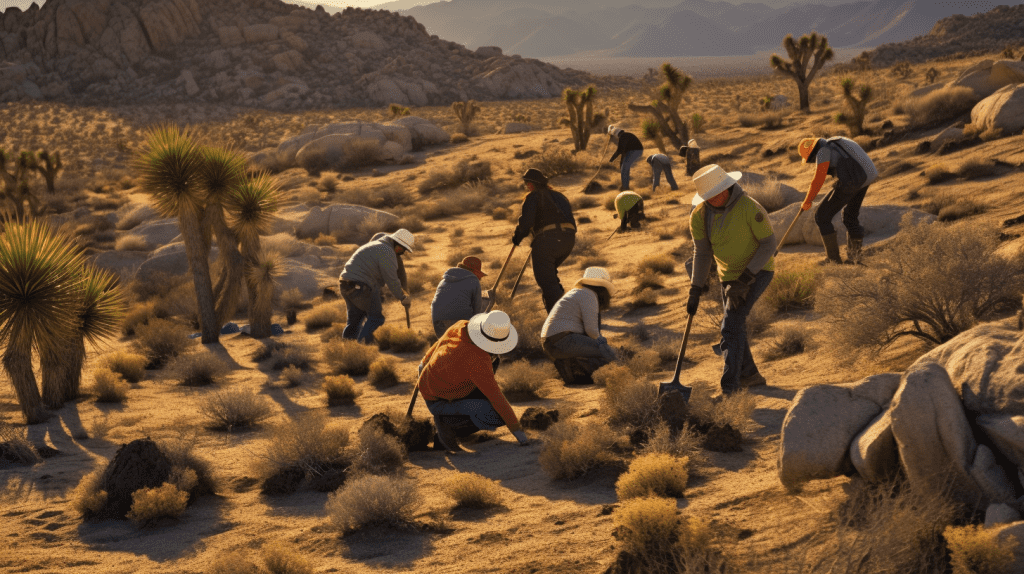
Looking for a way to give back and make a positive impact on the unique environment here? Why not consider volunteering in Joshua Tree?
Community involvement is crucial when it comes to preserving and protecting this beautiful national park. By volunteering, you can help maintain trails, assist with educational programs, participate in restoration projects, and even monitor wildlife populations.
Not only will you be making a difference in the environmental impact of the park, but you’ll also have the opportunity to connect with like-minded individuals who share your love for nature. Volunteering is an incredibly rewarding experience that allows you to learn new skills while giving back to the community.
So why not take some time out of your desert oasis adventure and contribute to the preservation of Joshua Tree National Park? As an added bonus, many volunteer opportunities come with free access to the park during your service period!
Now that you’ve considered giving back through volunteering, let’s explore some fun events and activities happening in Joshua Tree.
Events and Activities
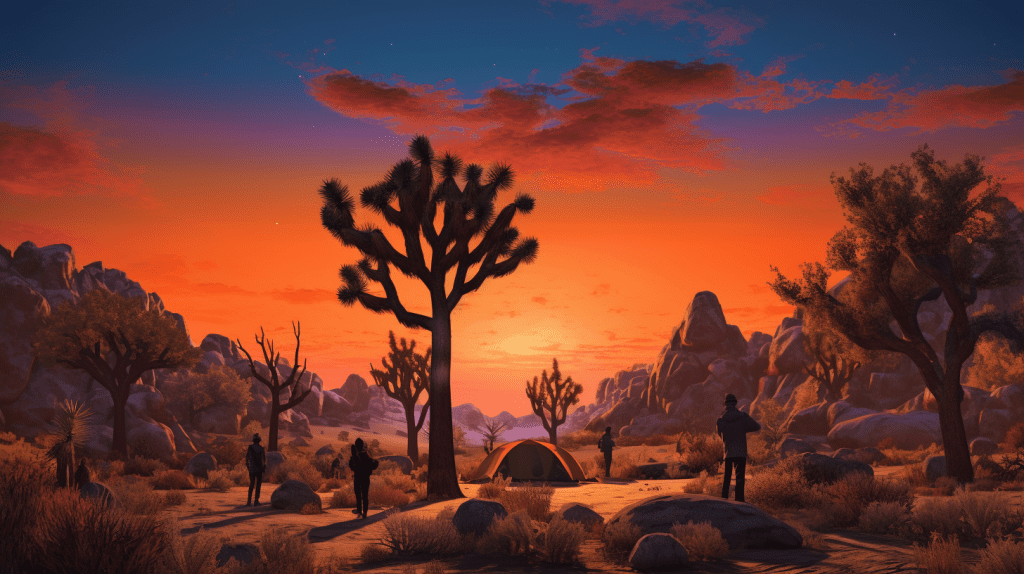
Now that you know about the volunteer opportunities available, let’s talk about the exciting events and activities happening in Joshua Tree National Park.
From outdoor concerts to ranger-led programs, there’s something for everyone to enjoy. Take a hike under the stars with the Night Sky program or learn about desert ecology on a guided tour.
Immerse yourself in the park’s unique culture by attending one of their many festivals or events throughout the year. With so much to do and see, you’ll never be bored while exploring Joshua Tree National Park.
So pack your bags and get ready for an adventure that’ll leave you feeling free and alive!
Frequently Asked Questions
What is the best time of year to visit Joshua Tree National Park?
The best time to visit Joshua Tree National Park is during the shoulder seasons of spring and fall. The seasonal climate is mild and there are fewer crowds compared to peak tourist months. Enjoy a sense of freedom as you explore this unique desert oasis.
Are there any guided tours available within the park?
Looking to explore Joshua Tree National Park on a guided tour? You’re in luck! There are plenty of options available for park exploration, including hiking tours and Jeep tours. Get ready for an adventure!
Can visitors bring their pets into the park?
Visitors are welcome to bring their pets into Joshua Tree National Park, but they must comply with the pet policies and leash laws. Enjoy exploring the park’s unique landscape with your furry companion by your side.
Can visitors camp in the park overnight?
You can pitch a tent in Joshua Tree National Park and spend the night under the stars. Make camping reservations beforehand, then enjoy nighttime activities like stargazing and listening to coyotes howl. It’s freedom at its finest.
Are there any restrictions on rock climbing within the park?
When rock climbing in Joshua Tree National Park, safety measures must be taken seriously. While there are no restrictions on climbing routes, it’s important to research and prepare properly before attempting popular climbs.
Conclusion
Congratulations on exploring Joshua Tree National Park! You’ve experienced the unique beauty of this desert oasis and learned about its history and conservation efforts.
As you leave the park, take a moment to reflect on the incredible wildlife and plant life that call it home. But your journey doesn’t have to end here.
Consider volunteering with one of the many organizations working to preserve this special place or returning for one of the park’s exciting events. Whether you’re a seasoned hiker or just looking for a peaceful escape, Joshua Tree National Park has something for everyone.
So pack your bags, hit the road, and discover all that this stunning destination has to offer!





